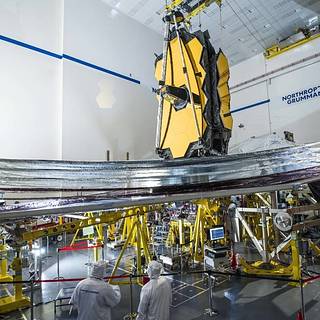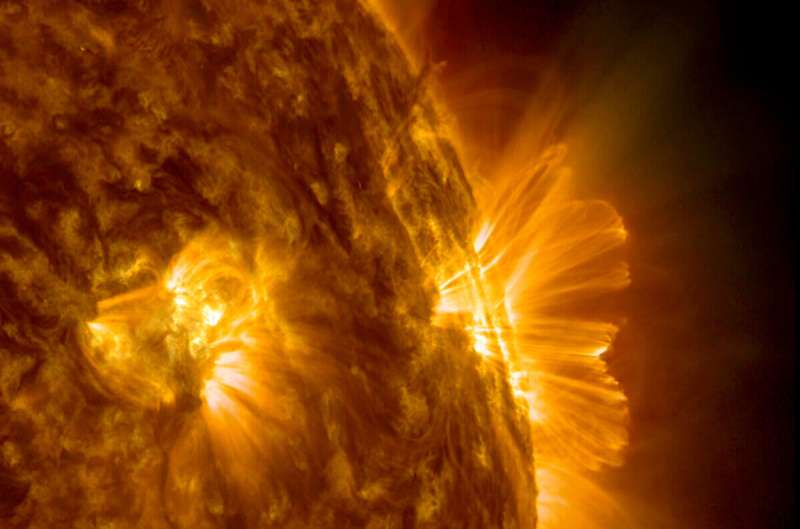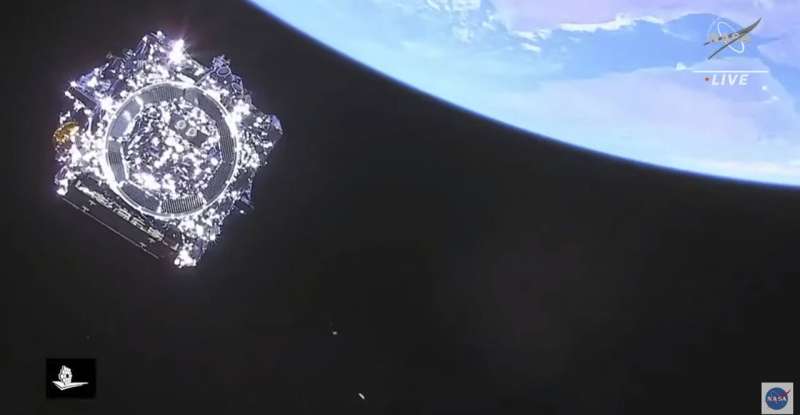
Copernical Team
Sunshield Successfully Deploys on NASA’s Next Flagship Telescope
 The James Webb Space Telescope team has fully deployed the spacecraft’s 70-foot sunshield, a key milestone in preparing it for science operations.
The James Webb Space Telescope team has fully deployed the spacecraft’s 70-foot sunshield, a key milestone in preparing it for science operations. NASA estimates metrics of exploding meteor that shook ground

A meteor that caused an earthshaking boom over suburban Pittsburgh on New Year's Day exploded in the atmosphere with an energy blast equivalent to an estimated 30 tons (27,216 kilograms) of TNT, officials said.
NASA's Meteor Watch social media site said late Sunday a "reasonable assumption" of the speed of the meteor at about 45,000 mph (72,420 kph) would allow a "ballpark" estimate of its size as about a yard in diameter with a mass close to half a ton (454 kilograms).
If not for the cloudy weather, NASA said, it would have been easily visible in the daytime sky—maybe about 100 times the brightness of the full moon.
A nearby infrasound station registered the blast wave from the meteor as it broke apart, enabling the estimates.
National Weather Service meteorologist Shannon Hefferan told the Tribune-Review that satellite data recorded a flash over Washington County shortly before 11:30 a.m. Saturday and officials believed it was due to a meteor "falling through the atmosphere." Hefferan said a similar event occurred Sept. 17 in Hardy County, West Virginia.
Residents in South Hills and other areas reported hearing a loud noise and feeling their homes shaking and rattling.
James Webb telescope begins crucial sun shield tensioning
 The James Webb Space Telescope began one of the most complicated parts of its deployment Monday as NASA sent commands to fully extend the first layer of the observatory's critical five-layer sunshield.
The $10 billion space telescope - the largest and most powerful in history - still is in the first half of its 29-day deployment schedule as it flies through space to a position over on
The James Webb Space Telescope began one of the most complicated parts of its deployment Monday as NASA sent commands to fully extend the first layer of the observatory's critical five-layer sunshield.
The $10 billion space telescope - the largest and most powerful in history - still is in the first half of its 29-day deployment schedule as it flies through space to a position over on Liquid-metal experiment provides insight into the heating mechanism of the sun's corona

Why the sun's corona reaches temperatures of several million degrees Celsius is one of the great mysteries of solar physics. A "hot" trail to explain this effect leads to a region of the solar atmosphere just below the corona, where sound waves and certain plasma waves travel at the same speed. In an experiment using the molten alkali metal rubidium and pulsed high magnetic fields, a team from the Helmholtz-Zentrum Dresden-Rossendorf (HZDR), a German national lab, has developed a laboratory model, and for the first time experimentally confirmed the theoretically predicted behavior of these plasma waves—so-called Alfvén waves—as the researchers report in the journal Physical Review Letters.
NASA's new space telescope 'hunky-dory' after problems fixed

Video: Orbital badminton in 360 degrees

Experience an orbital badminton match on the International Space Station ISS in 360° as ESA astronaut Matthias Maurer challenges his crewmates and Japanese spaceflight participants Yusaku Maezawa and Yozo Hirano.
Together with Roscosmos cosmonaut Alexander Misurkin, the Japanese spaceflight participants joined the current Expedition 66 crew for a short-term stay of 12 days on the ISS.
While their stay on the ISS focuses on scientific and operational activities, the astronauts on board the Space Station also enjoy recreational activities that provide an important balance for the crew and offer opportunities for intercultural exchange and team building.
Matthias was launched to the International Space Station on Crew Dragon Endurance as part of Crew-3 at 02:03 GMT/03:03 CET Thursday 11 November 2021. His ESA mission on board is known as Cosmic Kiss and will see him live and work for approximately six months in orbit.
Explore further
Integrated photonics meets electron microscopy
 The transmission electron microscope (TEM) can image molecular structures at the atomic scale by using electrons instead of light, and has revolutionized materials science and structural biology. The past decade has seen a lot of interest in combining electron microscopy with optical excitations, trying, for example, to control and manipulate the electron beam by light. But a major challenge has
The transmission electron microscope (TEM) can image molecular structures at the atomic scale by using electrons instead of light, and has revolutionized materials science and structural biology. The past decade has seen a lot of interest in combining electron microscopy with optical excitations, trying, for example, to control and manipulate the electron beam by light. But a major challenge has Say hello to a record-setting isotope
 In collaboration with an international team of researchers, Michigan State University has helped create the world's lightest version, or isotope, of magnesium to date.
Forged at the National Superconducting Cyclotron Laboratory at MSU, or NSCL, this isotope is so unstable, it falls apart before scientists can measure it directly. Yet this isotope that isn't keen on existing can help resear
In collaboration with an international team of researchers, Michigan State University has helped create the world's lightest version, or isotope, of magnesium to date.
Forged at the National Superconducting Cyclotron Laboratory at MSU, or NSCL, this isotope is so unstable, it falls apart before scientists can measure it directly. Yet this isotope that isn't keen on existing can help resear NASA selects 4 university teams for aviation projects
 NASA's research focus on sustainable aviation will get some big help from teams of university faculty and students recently selected to participate in the agency's University Leadership Initiative (ULI).
ULI gives the academic community an opportunity to support NASA's aeronautical research goals and provide students with valuable experience in solving real-world technical challenges.
NASA's research focus on sustainable aviation will get some big help from teams of university faculty and students recently selected to participate in the agency's University Leadership Initiative (ULI).
ULI gives the academic community an opportunity to support NASA's aeronautical research goals and provide students with valuable experience in solving real-world technical challenges. Quantum marbles in a bowl of light
 Which factors determine how fast a quantum computer can perform its calculations? Physicists at the University of Bonn and the Technion - Israel Institute of Technology have devised an elegant experiment to answer this question. The results of the study are published in the journal Science Advances.
Quantum computers are highly sophisticated machines that rely on the principles of quantum
Which factors determine how fast a quantum computer can perform its calculations? Physicists at the University of Bonn and the Technion - Israel Institute of Technology have devised an elegant experiment to answer this question. The results of the study are published in the journal Science Advances.
Quantum computers are highly sophisticated machines that rely on the principles of quantum 